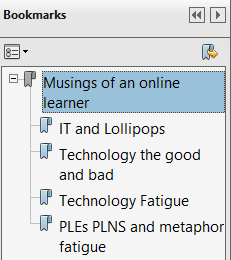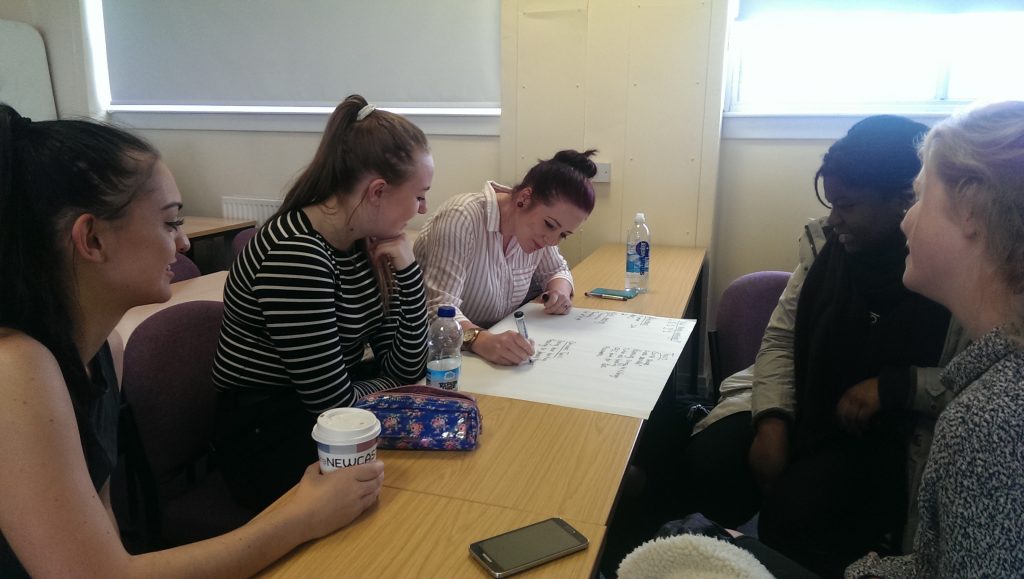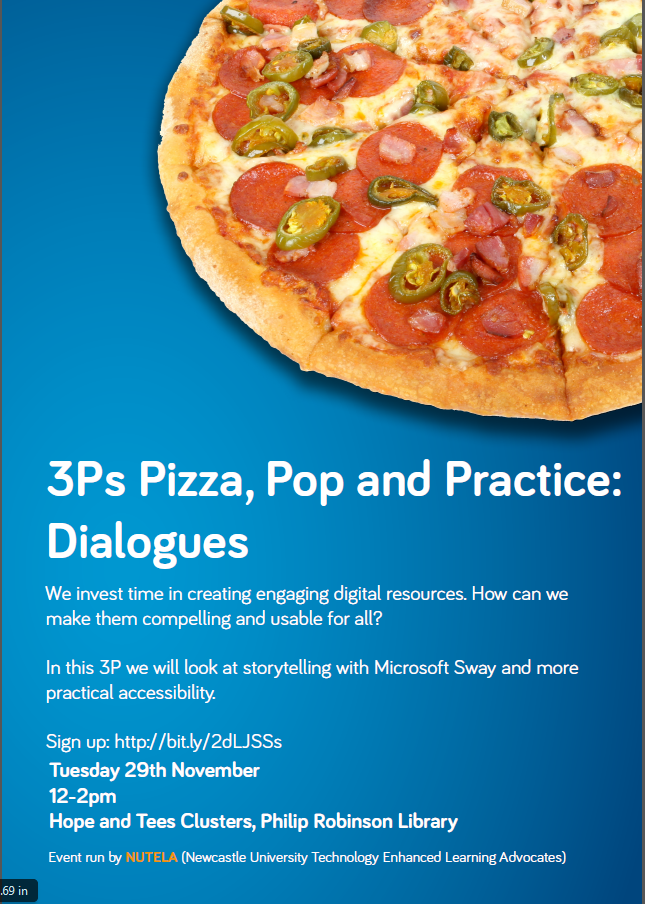In 2015-16 the following awards were made:
- 8 Responsive Projects, each for up to £2,500
- 1 Strategic Project, for up to £10,000
Details of all the projects can be found in the 2015/16 list of funded projects.
In 2015-16 the following awards were made:
Details of all the projects can be found in the 2015/16 list of funded projects.
In this session we demonstrated the functionality of Microsoft’s digital storytelling app.
We then presented a case study on how the software has been used to create Research Digistories as online educational resources for research students. In the case study, Sways have been created using past student work and focus not on the product of the research but on the externalisation of the hidden and personal knowledge involved in the research process itself.
Sway is available to all staff and students by logging into sway.com with their Office 365 credentials. (campusID@newcastle.ac.uk and your university password)
We spend lots of time creating digital resources, how can we build in accessibility so that they can be used by the widest group of people?
In our 3P session we explored a few ideas
As well as helping learners who are hard of hearing. Captions and transcripts also help:
In this activity we’d like to show you how to add subtitles to a video on YouTube. You’ll need a video, a script and a google account.
Feel free to use the following example files that we used in the Nutela session.
Sign into YouTube with your own google account
You will now see an option under “My Drafts”.
Now you can check that it has aligned it correctly by listening to the video and make any changes.
You should see the following video, click on the CC button to view the captions.
(Our demo video is about how we generate subtitles when we don’t have a script.)
If you don’t have a script for your video you may be able to make use of the automatic subtitles which YouTube adds to all videos.
[Huge thanks to Eleanor Lockhart for preparing these instructions and screenshots for the hands-on session.]
LTDS are running an ULTSEC Innovation Fund workshop on December 12th 2-3pm in KGVI 1.36C. You will be given an overview of the fund as well as guidance from the Careers Service about how to employ students for your project. There will also be presentations from successful project teams from previous years who will share details of their project and the application process.
To sign up to this workshop please do so via the following link: http://www.ncl.ac.uk/ltds/about/training/ultsecinnovation/workshops/. We would love to see you there.
Further information including key dates and application forms and guidance can be found on the Innovation Fund section of the LTDS website: http://www.ncl.ac.uk/ltds/funding/teaching/
Imagine that a 20 page PDF arrives in your mailbox.
There are a few things that document authors can do to make a PDF more useable.
Top of my list would be:
Let’s explore these with a few examples.
Note: For the PDF examples in this post, you’ll need to download these to a folder on your PC, navigate to the folder and open them with Adobe Reader. We want to make use of a few features in Adobe Reader and don’t want to open them in a browser.
You can quickly work out whether a pdf has any text in it, or just contains images of words by
Try this:
In comparison try the same things with a version containing text.
v2-musings-text-only
You’ll have seen Version 2 is a bit better. It has text, and there look to be some headings.
The downside is that the headings have been created by making the text bold, not by marking them as headings. As a consequence we don’t see anything at all in the page navigation.
Let’s look at V3: v3-musings-with-headings
This one has bookmarks, so I can see the structure.
 This is only a short example, but imagine if it was longer! The heading structure shown in the bookmarks would really help me understand the flow of the document and revisit pertinent sections once i had read it.
This is only a short example, but imagine if it was longer! The heading structure shown in the bookmarks would really help me understand the flow of the document and revisit pertinent sections once i had read it.
If you are making your own pdfs from Word documents it’s easy to add these bookmarks in.
Next: we’ll ask you to create a word document, add headings and save it to a PDF.
 Your document should look something like this:
Your document should look something like this:
Save and open your PDF – you should see the headings as bookmarks.
If you are reading through the documents using a screen reader or text to speech programme the reading order is vital.
If you generate pdfs from Word the reading order is normally OK, but floating text boxes rarely end up being read in a sensible place. However, the reading order on some pdfs that have been designed for print can be disasterous!
Here’s a really bad example: v4-newsletter-example
Fixing this kind of problem can be time consuming. You can get someway with Adobe Acrobat Pro (Touch up Reading Order), but a better approach is often to go back to the original author.
By definition PDFs are designed to be printed. If people want to increase the font size the only way they can do it is by zooming the document, and they will loose information off the side of the screen.
In contrast if the same information is on a Word document or a Web page this can be zoomed much more easily. (Try Word’s Web layout), and although PDFs can be annotated in Adobe Reader and other tools, many students would prefer to edit a standard document.
Also, think carefully before you add passwords to prevent editing, copying and annotating – these can really impact useability.
Try annotating v3-musings-with-headings if you want to see how frustrating it is.
Numbas is a web-based assessment system with an emphasis on mathematics. It helps users to build sophisticated online tests suitable for numerate disciplines, including support for interactive graphs, statistical functions and the assessment of algebraic expressions.
Suitable for both practice and in-course assessment, Numbas tests integrate seamlessly with Blackboard, returning marks to Grade Center and offering the opportunity to download scores and reports directly from the tool.
Numbas is used in a wide range of subject areas here at Newcastle University, including accounting, biomedical sciences, engineering, physics and psychology. It is also used to deliver online support material in the ASK Academic Skills Kit.
Developed here at Newcastle University by the School of Mathematics & Statistics e-learning unit, Numbas is an open source project with users and partners around the world. More information can be found on the Numbas public website.
The Numbas section of the LTDS blog is in its infancy, however the team is very happy to answer any queries: numbas@ncl.ac.uk.
With the Peer Mentoring Scheme well underway across the University, mentors have been meeting with convenors to check how things are going.
Alison Graham convenes the Peer Mentors in the School of Biology.

She meets with Peer Mentors in the school in week 2, week 4 and week 7 or 8, just to check how students are doing and make sure that mentors and mentees are getting the most out of the scheme.
‘What I’ve started to try to do is to incentivise the meetings, so the students feel that they are getting something out of them, as well as just catching up.
‘I came up with the idea of tying them to the Graduate Skills Framework, so I often work through how the mentors will be able to use their skills in applying for jobs.
‘We go through how to evidence the skills that they’ve gained in applications and at interview.’
Alison hopes that this approach will make the scheme more lucrative for second and third year students who may be unsure about giving up their time.
‘It’s really about making sure that students can see and really use the skills they are gaining form being a Peer Mentor, in addition to helping other students.’
Alison says the scheme has proved popular in the School and that students have described it as useful but that often the whole experience relies on engagement from the mentors.
‘We have some excellent mentors who establish a real social group and relationship with their mentees by organising trips and events.
‘We try to encourage that and encourage teamwork within the groups – for example, we organise a treasure hunt in week one where they all have to work together.’
She says that the amount of engagement with mentors depends on individual students and often to circumstances.
‘But it depends on them. Some students only really liaise with their mentor in the first few weeks but some need a little bit more.
‘They also tend to turn to their mentors around exam and assignment time.
‘But it can also be really important for some students who are struggling.’
As a convenor for the programme, Alison points out that its important for the mentors to be trained and supported so that they know what queries they can answer.
‘We have to be quite careful to make sure that they know how much help they can give students with their academic work.
‘Obviously they can provide some advice but we don’t want people sharing assignments or anything, so that’s something we have to train them for.’
As well as the feedback meetings, Peer Mentors have all been invited to a Thank You party, taking place on 5th December in the Great North Museum.
Claire Burnham, the University’s Peer Mentoring Coordinator said: ‘We’re very excited about the event.
‘The Mentor of the year award will be presented on the night and we’ve already had 400 nominations from students across the University.
‘It’s a great way of rewarding our mentors and our convenors for all of their hard work.’
The next 3Ps: Pizza Pop and Practice workshop will take place on 29th November 2016.
 The topic is ‘Dialogues’ and draws together sessions on storytelling using Microsoft Sway and the complexities of designing materials accessible to all students.
The topic is ‘Dialogues’ and draws together sessions on storytelling using Microsoft Sway and the complexities of designing materials accessible to all students.
The event will take place between 12 and 2pm in the Hope and Tees Clusters of the Robinson Library.
There will, of course, be pizza and pop available before the workshops begin.
Please do register here.
We look forward to seeing you there!